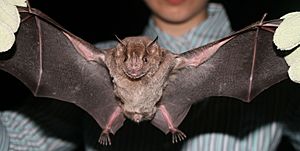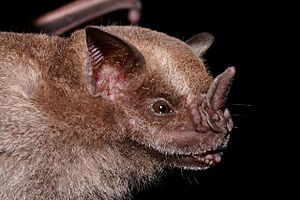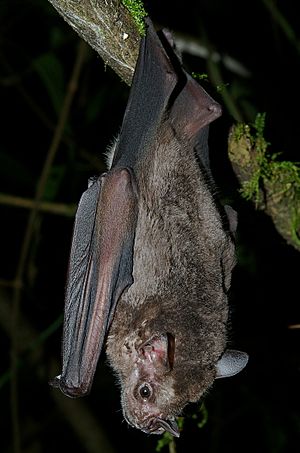Jamaican fruit bat facts for kids
Quick facts for kids Jamaican fruit bat |
|
|---|---|
 |
|
| Conservation status | |
| Scientific classification | |
| Genus: |
Artibeus
|
| Species: |
jamaicensis
|
 |
|
| Artibeus jamaicensis range | |
The Jamaican fruit bat (Artibeus jamaicensis) is a fascinating bat that loves to eat fruit. You might also hear it called the common or Mexican fruit bat. It lives in many places, from Mexico through Central America to parts of South America. You can also find it on many islands like the Greater Antilles and Lesser Antilles, and sometimes in the Southern Bahamas.
Bats found east of the Andes mountains in South America are now often thought to be a different species called the flat-faced fruit-eating bat (A. planirostris). A special thing about the Jamaican fruit bat is that it doesn't have an outside tail. It also has a small, U-shaped membrane between its legs.
Contents
What They Look Like
The Jamaican fruit bat is a medium-sized bat. It is about 78–89 mm (3.1–3.5 in) long. Its wings can spread out about 96–150 mm (3.8–5.9 in) wide. These bats usually weigh between 40 to 60 g (1.4 to 2.1 oz).
They have wide, pointed ears with a jagged edge. Their nose has a special leaf-like shape. The lower lip has small bumps, with a slightly larger one in the middle.
Their fur on the back is a grayish or brownish color. You can see white at the base of their hairs. Their face often has different fur patterns. The wings are wide and dark gray. The fur underneath is lighter. These bats do not have an external tail. They have a narrow, hairless membrane between their legs.
Where They Live and What They Eat
The Jamaican fruit bat lives in many areas. Its home stretches from southern Mexico down to northwestern South America. This includes countries like west Colombia, west Ecuador, and northwest Peru. They also live on islands such as Trinidad, Tobago, the Greater Antilles, and the Lesser Antilles. You can even find them in the Florida Keys.
These bats can live from sea level up to about 2,135 m (7,005 ft) high. They like humid, tropical places best. But they can also live in cloud forests and drier tropical areas.
Jamaican fruit bats find shelter in many spots. They roost in caves, hollow trees, and thick leaves. They also use buildings. Sometimes, they even make their own "tents" by folding large leaves. These leaf tents are only used for a short time.
The Jamaican fruit bat is a frugivore, which means it eats fruit. They eat many kinds of fruit, but they especially love figs. For example, on Barro Colorado Island in Panama, figs make up over 78% of the fruit they eat. They might also eat plant leaves that are rich in protein.
When a fruit bat finds food, it picks it up with its mouth. Then it carries the fruit away to its roost to eat. This helps spread seeds far away. These bats can carry fruits weighing 3–14 g (0.11–0.49 oz). Some have even been seen carrying fruits as heavy as 50 g (1.8 oz)! They use their sight and smell to find fruits with certain colors and smells.
In the wild, a Jamaican fruit bat can live for up to nine years. Animals that hunt these bats include owls, snakes, large opossums, and coati.
Life Cycle and Behavior
When Jamaican fruit bats are in their roosts, males will claim an area as their territory. Females then choose the best territories to rest and mate in. Young males might stay in the roost where they were born. Females, however, might leave to join other females elsewhere.
In large caves with many roosting spots, males will actively protect females during breeding times. They will chase away other males who try to enter their group. But they usually allow younger males to stay with them. These younger males are more common in bigger groups. Older and younger males sometimes work together to protect the females. In big groups, the dominant male might even be the father of the younger males.
When bats go out to find food, the dominant males are usually the first to leave the roost. They are also the last to come back. At dusk, males spend a lot of time flying near the tree roosts. They make sure no other bats enter their area. Jamaican fruit bats are most active around midnight. After that, their activity starts to slow down.
If a Jamaican fruit bat is caught, it will make a warning call. This call is a long series of sounds that helps other bats know there is danger. These bats also react to the warning calls of other bat species. They are known as "whisper bats" because they make quiet sounds while flying and resting.
Jamaican fruit bats usually have two breeding seasons each year. Births depend on how much fruit is available. Females typically give birth to one young bat at a time. Mating happens most often at the end of the wet season. Babies are born during the dry months.
Sometimes, the development of the baby inside the mother can slow down. But the birth will still happen in the next breeding period. Male bats' testes get bigger when females are ready to mate.
Mating happens about 2 to 25 days after the previous births. Pups born in a group might sometimes be fathered by other males, depending on the group's size. Pregnancy usually lasts about 3.5 to 4 months. But it can be as long as 7 months if the baby's development is delayed.
The female bat gives birth while hanging upside down. The newborn comes out head first, all by itself. Mothers will eat the placenta after birth. Mothers carry their pups when they are very young. But later, they leave them in the roost during the day.
Young bats stop drinking milk around 15 days old. They get all their adult teeth by 40 days old. They can fly by 50 days old, when their forearms are fully grown. Females can have babies when they are about eight months old. Males are ready to mate by 12 months old.
Status
The Jamaican fruit bat is very common in most places where it lives. It is considered a very important bat in wet habitats because it helps spread seeds. From a conservation point of view, the Jamaican fruit bat does not seem to be in danger. It is common even if its habitat is disturbed. However, in some areas, it might cause damage to fruit crops.
See also
 In Spanish: Murciélago frugívoro de Jamaica para niños
In Spanish: Murciélago frugívoro de Jamaica para niños




